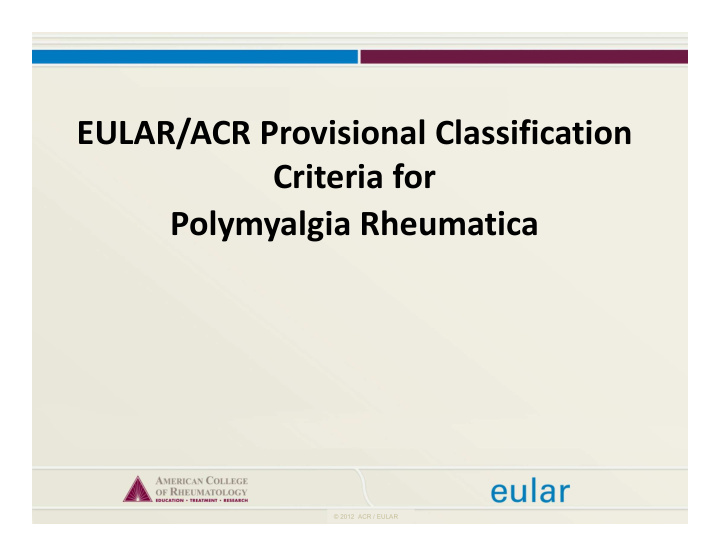



EULAR/ACR Provisional Classification Criteria for Polymyalgia Rheumatica �������������������
Members of the Development Group Christian Dejaco , Department of Rheumatology, Medical University Graz, Graz, Austria Christina Duftner , Department of Internal Medicine, General Hospital of the Elisabethinen, Klagenfurt, Austria Michael Schirmer , Department of Internal Medicine I, Medical University Innsbruck, Innsbruck, Austria Hanne Slott Jensen , Gentofte Hospital, Rheumatology Division, Hellerup, Denmark Pierre Duhaut , Service de Médecine Interne, Amiens, France Wolfgang A. Schmidt , Immanuel Krankenhaus Berlin, Medical Center for Rheumatology Berlin-Buch, Germany Gyula Poór , National Institute of Rheumatology and Physiotherapy, Budapest, Hungary Novák Pál Kaposi , Radiology Department, National Institute of Rheumatology and Physiotherapy, Budapest, Hungary Peter Mandl , General and Pediatric Rheumatology Department, National Institute of Rheumatology and Physiotherapy, Budapest, Hungary Peter V. Balint , General and Pediatric Rheumatology Department, National Institute of Rheumatology and Physiotherapy, Budapest, Hungary Zsuzsa Schmidt , National Institute of Rheumatology and Physiotherapy, Budapest, Hungary Annamaria Iagnocco , Rheumatology Unit, Clinica e Terapia Medica Department, Sapienza Università di Roma, Rome, Italy Carlo Salvarani , Department of Rheumatology, Arcispedale S. Maria Nuova, Reggio Emilia, Italy Carlotta Nannini , Rheumatology Unit, Ospedale Misericordia e Dolce, Prato, Italy Fabrizio Cantini , Rheumatology Unit, Ospedale Misericordia e Dolce, Prato, Italy Pierluigi Macchioni , Department of Rheumatology, Arcispedale S. Maria Nuova, Reggio Emilia, Italy Marco Cimmino , Dept. of Internal Medicine, University of Genoa, Genoa, Italy Nicolò Pipitone , Department of Rheumatology, Arcispedale S. Maria Nuova, Reggio Emilia, Italy Artur Bachta , Dept. of Internal Medicine and Rheumatology, WIM CSK MON, Warsaw, Poland Georgina Espígol-Frigolé, Center for Diagnosis Imaging, Hospital Clínic, Montserrat del Amo, Barcelona, Spain �������������������
Members of the Development Group Maria Cid , Dept. of Internal Medicine, Hospital Clinic Provincial, Barcelona, Spain Víctor M. Martínez-Taboada , Servicio de Reumatología, Universidad de Cantabria, Santander, Spain Elisabeth Nordborg , Sahlgren University Hospital, Department of Rheumatology, Göteborg, Sweden Haner Direskenel , Department of Rheumatology, Marmara University Medical School, Istanbul, Turkey Sibel Zehra Aydin , Department of Rheumatology, Marmara University Medical School, Istanbul, Turkey Kkalid Ahmed , Department of Rheumatology, Princess Alexandra Hospital, Harlow, United Kingdom Bhaskar Dasgupta , Department of Rheumatology, Southend University Hospital, Essex, United Kingdom Brian Hazelman , Department of Rheumatology, Cambridge University, Cambridge, United Kingdom Colin Pease , Rheumatology and Rehabilitation Research Unit, University of Leeds, Leeds, United Kingdom Raashid Luqmani , Nuffield Department of Orthopaedics, Rheumatology and Musculoskeletal Sciences, Oxford University, Oxford, United Kingdom Richard J. Wakefield , Rheumatology and Rehabilitation Research Unit, University of Leeds, Leeds, United Kingdom Andy Abril , Division of Rheumatology, Mayo Clinic College of Medicine, Jacksonville Florida, USA Clement J. Michet , Department of Internal medicine, Division of Rheumatology, Mayo Clinic, Rochester, Minnesota, USA Cynthia S. Crowson , Department of Health Sciences Research, Mayo Clinic, Rochester, Minnesota, USA Eric L. Matteson , Division of Rheumatology and Department of Health Sciences Research, Mayo Clinic, Rochester, Minnesota, USA Hilal Maradit Kremers , Department of Health Sciences Research, Mayo Clinic, Rochester, Minnesota, USA Kenneth T. Calamia , Division of Rheumatology, Mayo Clinic College of Medicine, Jacksonville, Florida USA Ralph Marcus , Rheumatology Associates of North Jersey, Teaneck, New Jersey, USA Mehrdad Ma z, Department of Internal Medicine, Division of Rheumatology, Mayo Clinic, Scottsdale, Arizona, USA Neil J. Gonter , Rheumatology Associates of North Jersey, Teaneck, New Jersey, USA Rickey E. Carter , Department of Health Sciences Research, Mayo Clinic, Rochester, Minnesota, USA �������������������
Funding � EULAR � ACR � Mayo Clinic � Biobanque de Picardie � In-kind donations of time, effort and expense by each of the investigators and their staffs �������������������
Background � PMR is the most common inflammatory rheumatic disease of the elderly. � Accurate diagnosis is difficult in PMR because proximal pain and stiffness syndrome, a commonly accepted phenotype of PMR, can occur in many other rheumatologic and inflammatory illnesses. � Lack of standardized classification criteria has been a major factor hampering development of rational therapeutic approaches to management of PMR. �������������������
General Approach to PMR �������������������
Classification Criteria for PMR are Needed for Major Reasons � To classify this clinical syndrome as a distinct disease entity � To compare like groups of patients across populations of patients seen in different countries � To facilitate prediction of disease- and treatment-related outcomes � To develop management guidelines across different treatment settings �������������������
Objective To develop EULAR/ACR classification criteria for PMR by assessing the performance of candidate criteria in a prospective longitudinal study of patients presenting with new onset bilateral shoulder pain. �������������������
Methods � Candidate inclusion/exclusion criteria for classification of PMR were defined through a consensus conference and a wider Delphi survey � International prospective study (21 centers in 10 countries) to evaluate the utility of candidate criteria for PMR in patients presenting with the polymyalgic syndrome � Study population: 125 subjects with PMR and 169 comparison subjects with conditions mimicking PMR (49 RA, 29 new-onset seronegative arthritis or connective tissue disease, 52 shoulder conditions, 39 other) � Follow-up: Baseline, weeks 1, 4, 12 and 26 � Statistical analyses: chi-square and rank sum tests, logistic regression models, concordance c statistic, factor analyses, classification trees, gradient boosting regression tree models �������������������
Study Design �������������� ��������� ����� 1�2��34 1��4 ����������������� �������� �������� �������� 5 5 5 ������� �����! "����!� ������!� �#����!� Measurements Measurements Measurements Measurements Measurements � ���� � ���� � ���� � ���� � $�%�&��'(��� � .�����/��(���'- � .�����/��(���'- � .�����/��(���'- � .�����/��(���'- � )�������&�� � �(-������0'������ � �(-������0'������ � �(-������0'������ � �(-������0'������ � *��&(�+�(��&(� �����/�%�������� �����/�%��������� �����/�%�������� �����/�%�������� � ,�%��-�(�����- � ���������/ � ���������(�����- � ���� � .�����/��(���'- � �(-������0'������ �����/�%������� � ���������/ �������������������
Recommend
More recommend